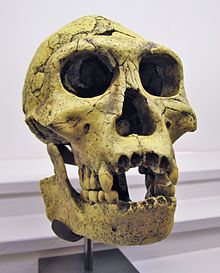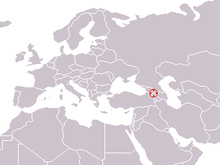
Back Dmanisi-hominiene Afrikaans إنسان جورجيا Arabic Homo georgicus Azerbaijani گورجو آدام AZB Дманісійскі гамінід Byelorussian Homo georgicus Bulgarian Home de Geòrgia Catalan Homo georgicus Czech Homo erectus georgicus Welsh Homo georgicus Danish

The Dmanisi hominins,[1][2][3] Dmanisi people,[4] or Dmanisi man[5] were a population of Early Pleistocene hominins whose fossils have been recovered at Dmanisi, Georgia. The fossils and stone tools recovered at Dmanisi range in age from 1.85 to 1.77 million years old,[6][7][8] making the Dmanisi hominins the earliest well-dated hominin fossils in Eurasia and the best preserved fossils of early Homo from a single site so early in time, though earlier fossils and artifacts have been found in Asia. Though their precise classification is controversial and disputed, the Dmanisi fossils are highly significant within research on early hominin migrations out of Africa. The Dmanisi hominins are known from over a hundred postcranial fossils and five famous well-preserved skulls, referred to as Dmanisi Skulls 1–5.
The taxonomic status of the Dmanisi hominins is somewhat unclear due to their small brain size, primitive skeletal architecture, and the range of variation exhibited between the skulls. Their initial description classified them as Homo (erectus?) ergaster (an otherwise African taxon), or potentially an early offshoot of later Asian H. erectus. The discovery of a massive jaw, D2600, in 2000 led researchers to hypothesize that more than one hominin taxon had been present at the site and in 2002, the jaw was designated as the type specimen of the new species Homo georgicus. Later analyses by the Dmanisi research team have concluded that all the skulls likely represent the same taxon with significant age-related and sexual dimorphism, though this is not a universally held view. In 2006, the team favoured subsuming the taxon under Homo erectus as H. erectus georgicus or H. e. ergaster georgicus. The nomenclature is still debated.

Anatomically, the Dmanisi hominins exhibited a mosaic of traits, possessing some features reminiscent of later and more derived H. erectus and modern humans, while retaining features of earlier Homo and Australopithecus. The length and morphology of their legs was essentially modern and they would have been adapted to long-range walking and running, but their arms were likely more similar to the arms of Australopithecus and modern non-human apes than to later hominins. The Dmanisi hominins would also have differed from later (non-insular) Homo in their small body (145–166 cm; 4.8–5.4 ft) and brain size (545–775 cc), both of which are more comparable to H. habilis than to later H. erectus. Morphological traits unifying all of the skulls, though the degree in which they are pronounced differ, include large brow ridges and faces.
In the Pleistocene, the climate of Georgia was more humid and forested than it is today, comparable to a mediterranean climate. The Dmanisi fossil site was located near an ancient lake shore, surrounded by forests and grasslands and home to a diverse fauna of Pleistocene animals. The favourable climate at Dmanisi might have acted as a refuge for hominins in the Early Pleistocene and it would have been reachable from Africa through the Levantine corridor. Stone tools found at the site are of the Oldowan tradition.
- ^ Pontzer et al. 2010, p. 492.
- ^ Lordkipanidze 2017, p. 50.
- ^ Agustí 2018, p. 74.
- ^ Lordkipanidze 2017, p. 49.
- ^ Vekua & Lordkipanidze 2010, p. 161.
- ^ Lordkipanidze et al. 2007, p. 305.
- ^ Ferring et al. 2011, p. 1.
- ^ Lordkipanidze et al. 2013, p. 326.
© MMXXIII Rich X Search. We shall prevail. All rights reserved. Rich X Search